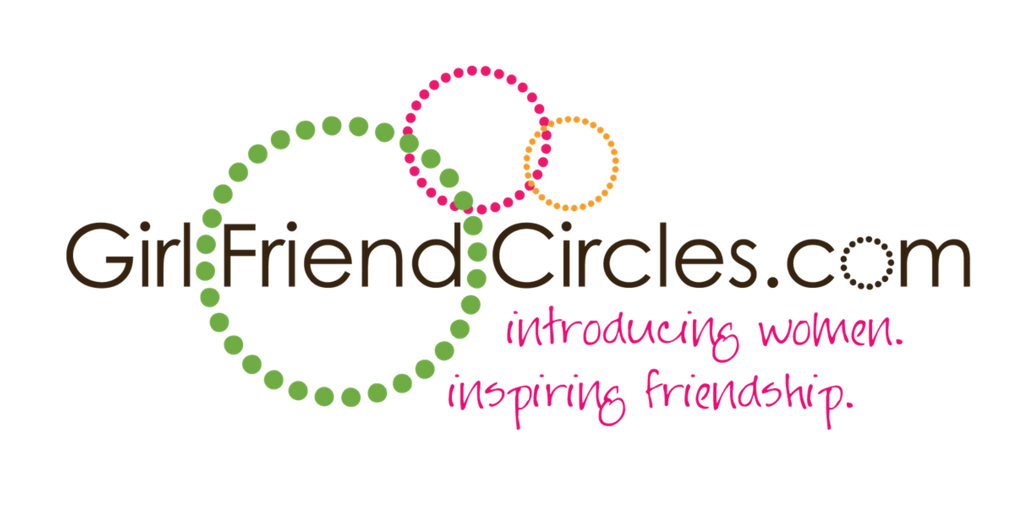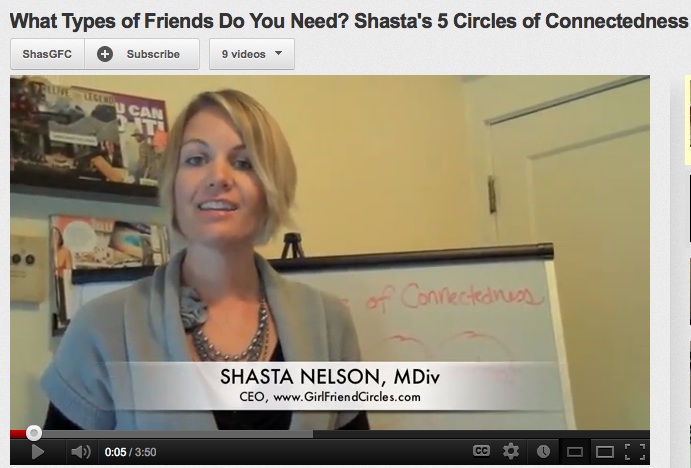The other night I was out with some new friends and, as often happens when someone finds out that my work is all about female friendships, women I barely know start to tell me their friendship woes. One very friendly woman in her mid-forties was explaining to me that she doesn't have time for friends anymore now that she's a mom. (sound familiar? read this post.) She went back-and-forth between defending her perceived reality and also sounding incredibly wistful. Like many of us in denial, we try to convince ourselves we're fine while simultaneously wishing things could be different. But then, her closing lines were, "Well I found out most of my previous friends weren't real friends anyway or they'd still be around. So who needs them, right?" She tried to laugh as though she didn't care.
A Refresher on Shasta's Circles of Connectedness
One of my favorite things to teach in workshops, which is also a big part of my upcoming book, is about the Five Circles of Connectedness. It's most often put to use when it comes to evaluating our current friendships or figuring out how to add new ones or deepen others. Today, I want to talk about it in the context of break-ups and unmet expectations.
You'll want to go catch up on the abbreviated definitions of Shasta's 5 Circles of Connectedness if you're not familiar with them already: Watch YouTube or Read a Previous Post.
But basically, the friends on the Left Side in the Contact and Common Circles are friendships where we more-or-less have one way of being together, one commonality holding us together. That is to say our friendships are largely dependent upon the fact that we both attend the same church, are part of the same mother's group, are both single, or because we work together.
To move someone over to the Right Side in the Community and Committed Circles means that we have added new ways of being together (i.e. brunch on the weekend in addition to whatever our original commonality was), have spent considerable one-on-one time together, and have increased our intimacy.
Confirmed Friends in the middle are for the women who used to be in our Committed Circle of best friends, but we no longer have the consistency with them that our Right-Side friendships require.
If we mistakenly believe that all our friendships are more-or-less the same then we may not have realistic expectations in place. Unmet expectations lead to disillusionment, and possible blame and anger toward the friends who aren't "there" for us.
There are SO many applications to our friendship Rifts and Drifts in these 5 Circles, but in the sensitivity of article length, I'll just mention the two most common misconceptions that can disappoint us if we don't understand our different types of friendships.
Two Common Misunderstandings in our Circles that Lead to Disappointment:
1) Assuming a Common Friend is a Commitment Friend. We can feel so close to someone at work, church, or our mothers group and mistakenly believe that they should "be there in big ways" for us just because we both really like each other, get a long well, and see each other consistently in that common setting.
But the truth about Common Friends is that unless we have co-created a friendship that extends beyond that shared commonality-- when that commonality ends, the friendship will inevitably Drift apart if someone doesn't intentionally try to create a new way of connecting. And that doesn't always work due to time, priorities, interests, etc. These friendships don't end because we don't like each other, but because we haven't yet practiced being together in new ways, outside of that commonality.
We get our feelings hurt when we stop attending church or change jobs and no one calls us anymore-- but if that place was what we had in common, then no matter how close we felt, we're the ones who left that friendship structure. If the thing we have in common is getting our families together on the weekends to go camping, but then we go through a divorce, unless we had another way of being together just as women, we risk Drifting apart when it's our ex-spouse who has all the camping equipment.
It's not her fault, even if the changes were in her life. In a friendship-- when we blame, we risk a Rift; if we decide we want to initiate consistently, we may be able to avoid a Drift.
If we can be honest in these moments and see them for what they are-- losing structures or commonalities that connected us-- then we can either find more peace in the Drift without us taking it personally or we more clearly see that we'll have to co-create new ways of being with that person. Which doesn't happen automatically.
2) Not realizing a Confirmed Friend is no longer a Commitment Friend. The other misunderstanding that can get the best of us is not realizing that just because we used-to-be-best friends, that while we still love each other so much, we no longer live near each other, talk regularly, or are present for each others lives in the same ways.
And if we haven't fostered new Commitment Friends where we now live, we're likely to make the mistake of wanting those Confirmed Friends to act like them. We'll be hurt when they don't know what's going on in our lives, forgetting that it is our responsibility to build up local friends who can care for us on the consistent basis.
Because of the intimacy and trust we've built with these women back in college or in a previous life phase, we certainly make decisions to call our Confirmed Friends to stay in touch with them better to support us through a season or to tell them honestly what we need. But hopefully they've developed close local friends that they are giving to so we want to be careful to not blame them for not reading our minds or knowing how to help us.
If we don't have strong relationships on the Right-Side, it becomes so easy to look to our other friends in the other Circles and begrudge them for not "being there" for us. It's so easy, when our life changes, to want everyone to be there for us that we sometimes forget that we never practiced that with each other beforehand or had yet built up to that Circle of Commitment.
If "she" wasn't "there" for you, was she really your friend?
To the beautiful woman who wondered aloud, "Well I found out most of my previous friends weren't real friends anyway or they'd still be around. So who needs them, right?" and to all of us who ask a variation of that rhetoric question, I say this:
I am so sorry that you were hurt and disappointed by what you hoped someone would be for you. That sucks. However, we don't have to devalue who they were or what we shared together. It's entirely possible they were a "real" friend, even if they weren't the Committed Friend we had hoped they were. Furthermore, the answer to previous disappointments isn't to give up on friendships altogether, but rather, to be sure to take responsibility for co-creating even stronger--more consistent and intimate--friendships this time around.
If you have questions-- ask them in the comments. It's sometimes impossible to be comprehensive on such a big subject in one posting! Hope the outline at least helps though?





